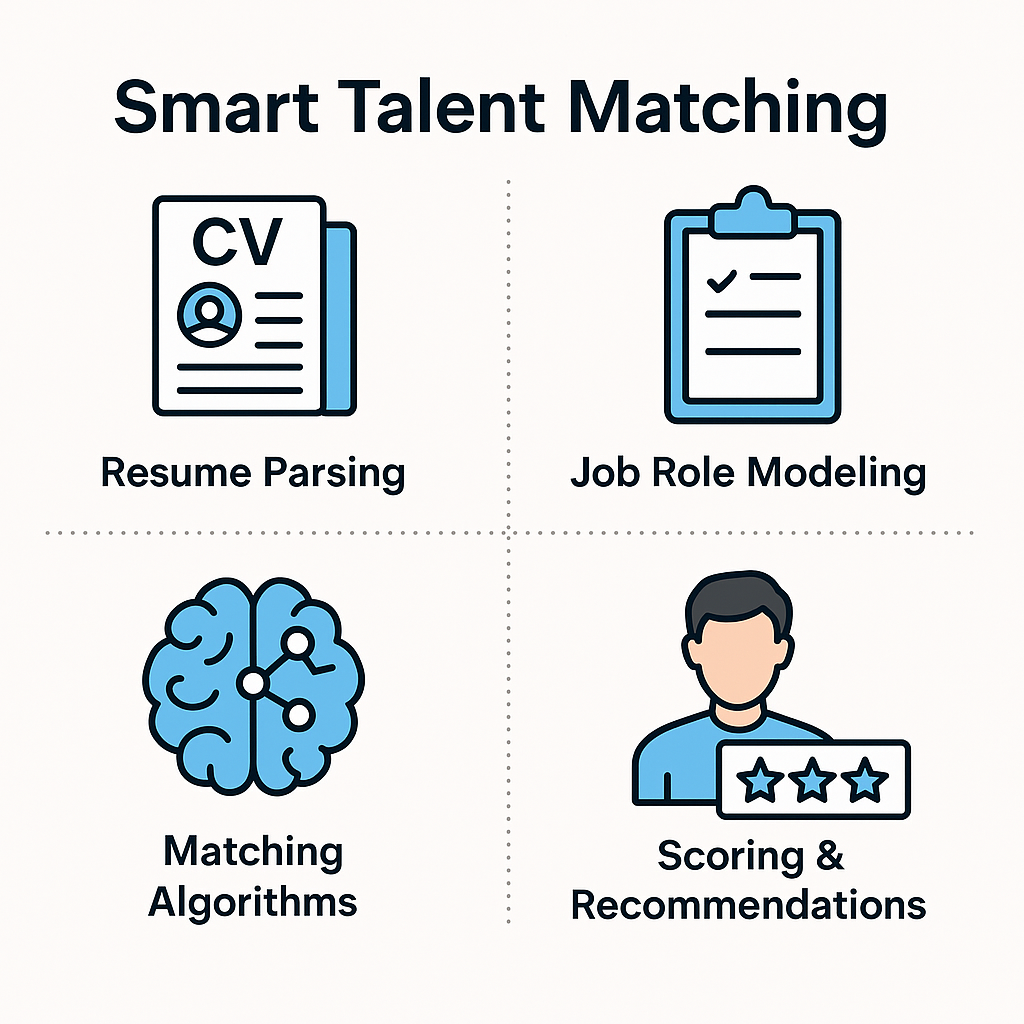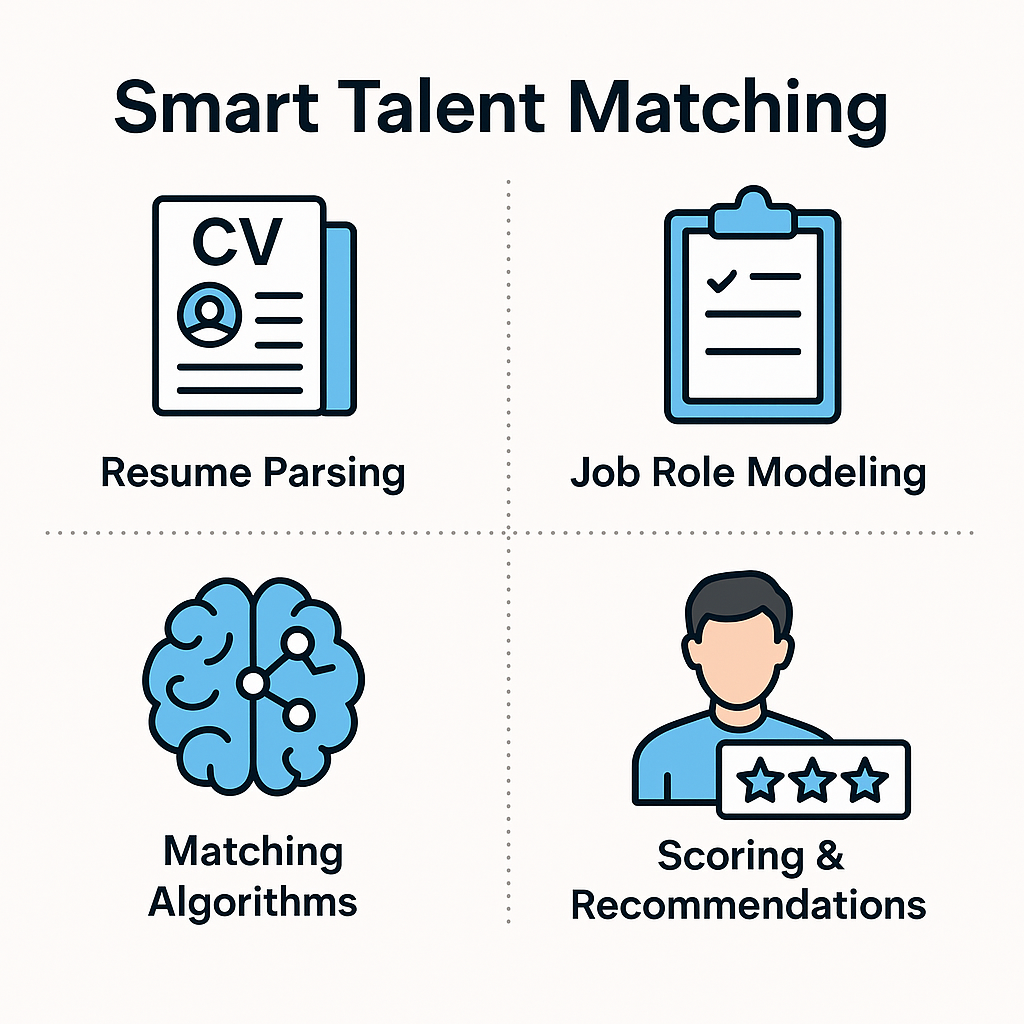Smart Talent Matching: How AI Is Redefining Recruitment Precision

In today’s ultra-competitive talent landscape, hiring isn't just about filling roles—it's about finding the right talent, fast. But with hundreds (if not thousands) of applicants for every role, how can recruiters consistently identify top talent without drowning in manual effort?
Enter Smart Talent Matching: a blend of AI, machine learning, and predictive analytics designed to revolutionize how we connect people with the jobs that fit them best.
🚀 What Is Smart Talent Matching?
Smart Talent Matching refers to the use of intelligent algorithms to match job seekers with open positions based on deep analysis of multiple data points—far beyond traditional keyword matching.
Instead of relying solely on resumes and job descriptions, smart systems analyze:
Skills and experience depth
Cultural and behavioral alignment
Career trajectory
Soft skills, adaptability, and potential
Performance indicators from past roles
Think of it as a matchmaker that understands context, nuance, and long-term compatibility—not just surface-level qualifications.
🔍 How Does It Work?
Resume Parsing and Structuring
Natural Language Processing (NLP) converts free-form resumes into structured data, extracting skills, roles, achievements, and more.Job Role Modeling
AI breaks down a job description into capability clusters, soft skills, and industry context—creating a dynamic “role profile.”Multi-layer Matching Algorithms
Semantic similarity scoring
Behavioral and psychometric modeling
Past candidate benchmarking
Diversity and inclusion balancing
Scoring and Explainability
Candidates are ranked based on a multi-dimensional fit score, and recruiters receive transparent insights into why each candidate is recommended.

🧠 Why It Matters in the Future of Work
With hybrid roles, cross-functional teams, and rapidly shifting skill demands, recruiters can no longer rely on static JD checklists. Smart Talent Matching helps organizations:
Move beyond resumes: Look at capability, potential, and cultural fit
Combat hiring bias: Use structured, fair evaluations at scale
Respond faster: Reduce time-to-hire with real-time candidate recommendations
Build future pipelines: Match candidates not just to jobs, but to growth opportunities
It’s not just about hiring for today—it’s about building adaptable teams for tomorrow.
🧭 Use Cases Across the Employee Lifecycle
Stage | Smart Matching Value |
|---|---|
Hiring | Recommend top-fit candidates instantly |
Internal Mobility | Identify talent for cross-functional or leadership roles |
Campus Recruitment | Sort through large applicant pools with high accuracy |
Talent Rediscovery | Re-activate “silver medalist” candidates from past pipelines |
Succession Planning | Map readiness levels and talent gaps for strategic roles |
🔮 What’s Next: Smart Matching + Generative AI
The next wave? Combining Smart Matching with Generative AI. Imagine an AI that not only finds the right candidate but auto-generates personalized outreach, writes interview questions, and even simulates culture fit assessments based on company values.
Smart Talent Matching will evolve from a support tool to a co-pilot in talent strategy.
HR Glossary: Master the Language of Modern HR
🙋♀️ Frequently Asked Questions (FAQ)
Q1: Is Smart Talent Matching only for large enterprises?
Not at all. Many scalable ATS and HCM platforms (like MokaHR) now offer AI-powered matching that adapts to both startups and enterprises.
Q2: Will AI replace human recruiters?
No. Smart Talent Matching enhances human decision-making by removing bias and surfacing hidden matches. Human empathy and judgment remain irreplaceable.
Q3: Can matching be tailored to specific company culture?
Yes. Advanced systems allow customization of weights (e.g., prioritize leadership skills, innovation mindset, etc.) and integrate cultural signals into the algorithm.
Q4: What data privacy concerns exist?
Reputable vendors ensure data is encrypted, anonymized where needed, and compliant with GDPR/CCPA regulations. Always review the provider's data policy.
Q5: How accurate is it?
Leading platforms report 2–3x improvements in quality-of-hire, time-to-fill, and recruiter satisfaction when Smart Matching is fully leveraged.
From recruiting candidates to onboarding new team members, MokaHR gives your company everything you need to be great at hiring.
Subscribe for more information

